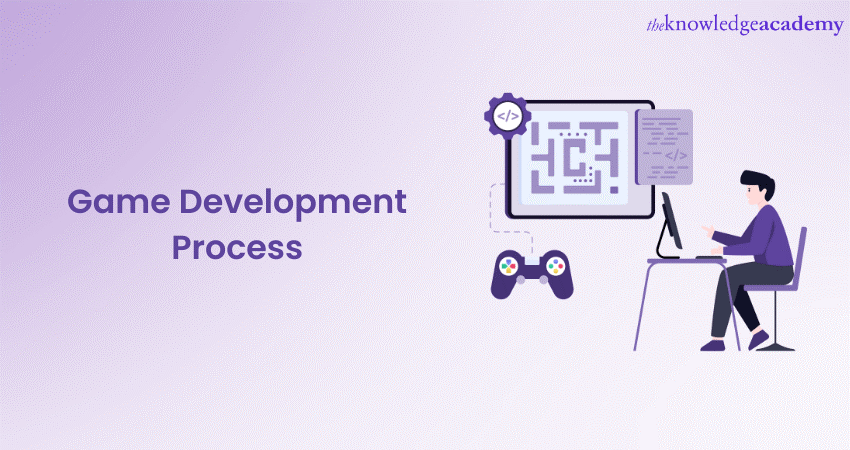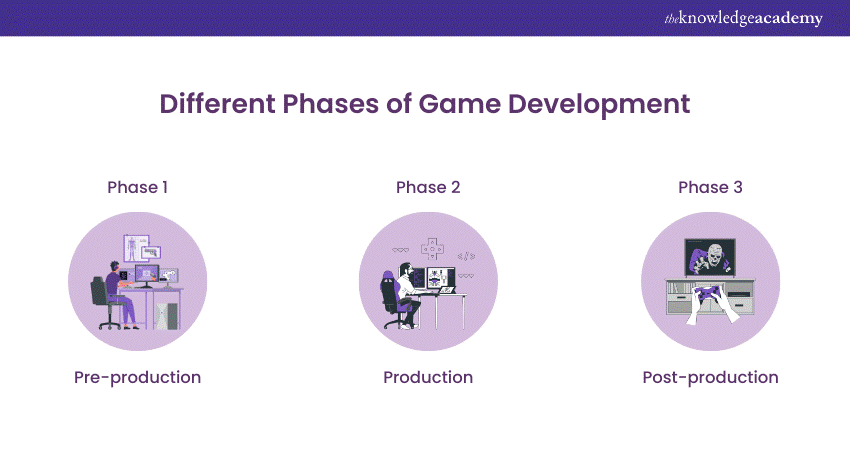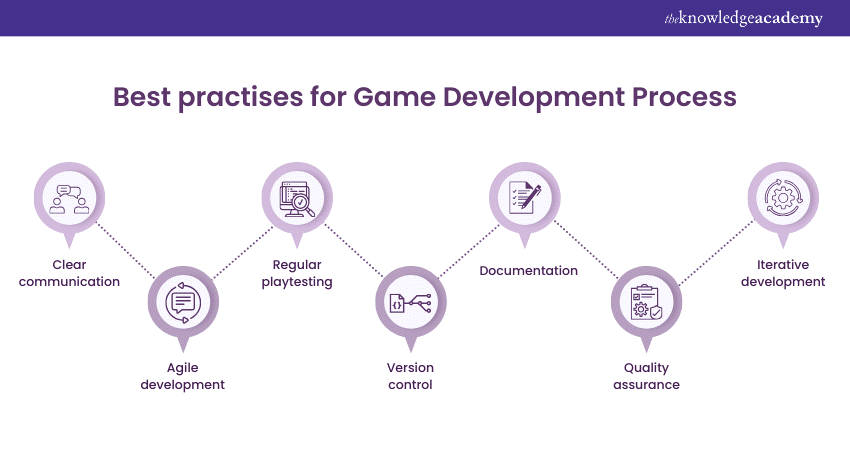We may not have the course you’re looking for. If you enquire or give us a call on 01344203999 and speak to our training experts, we may still be able to help with your training requirements.
Training Outcomes Within Your Budget!
We ensure quality, budget-alignment, and timely delivery by our expert instructors.

The Game Development Process is a comprehensive and systematic approach to creating video games that encompasses various stages, from conceptualisation to completion. It involves the collaboration of multidisciplinary teams, including designers, programmers, artists, and testers, working together to bring a game idea to life.
According to 2021 Barclay’s Games and Esports Report, the UK consumer market for games reached a record high of 7.16 billion GBP. Learn about the Game Development Process and how to plan and design captivating gameplay, create stunning visuals, and implement sound effects.
Table of Contents
1) Understanding What is the Game Development Process
2) Exploring the phases of the Game Development Process
3) Key Game Development roles
4) Best practices
5) Conclusion
Understanding What is the Game Development Process
The Game Development Process is a systematic approach to creating video games, encompassing various stages from concept to completion. It involves a combination of creative thinking, technical expertise, and meticulous planning to transform an idea into an interactive and engaging gaming experience.
The Game Development Process revolves around the creation of gameplay mechanics, visuals, sound design, and overall game design. It requires a multidisciplinary team consisting of game designers, programmers, artists, sound engineers, and quality assurance testers.
Furthermore, the Game Development Process typically begins with pre-production, where the game concept is fleshed out, market research is conducted, and a game design document is created. This phase sets the foundation for the game and helps establish the vision and direction.
Once the pre-production phase of the Game Development Process is complete, the production phase begins, which involves prototyping, asset creation, programming, level design, and quality assurance. The actual development of the game takes place at this stage, with the team working on different aspects simultaneously.
In the post-production phase of the Game Development Process, the game undergoes polishing, optimisation, and playtesting. This phase ensures that the game is refined, free of bugs and glitches, and ready for release. Its important to understand the whole process simultaneously choosing the right platform also. Here unity projects has the edge over its competitors with its seamless workflow.

Exploring the phases of the Game Development Process
Here are the phases of the Game Development Process, described in detail as follows:

1) Pre-production phase
a) Game idea conceptualisation: The first phase of Game Development is the conceptualisation of the game idea. This is where the creative process begins, as developers brainstorm and explore potential concepts, themes, and gameplay mechanics. The goal is to come up with a unique and compelling idea that forms the foundation of the game.
b) Market research and target audience analysis: Once the game idea is formulated in the Game Development Process, thorough market research is conducted. This involves analysing existing games in the market, identifying trends, and understanding the target audience. Market research helps developers determine the potential demand for their game, assess competition, and make informed decisions regarding the target market.
c) Game Design Document (GDD) creation: The creation of a Game Design Document (GDD) is a crucial step in the Game Development Process. The GDD serves as a blueprint for the entire project, outlining the game's mechanics, features, story, characters, levels, and overall design. It acts as a reference document for the development team, ensuring a shared understanding of the game's vision and goals.
d) Game concept art development and visual styling: In this phase of the Game Development Process, artists and designers work on creating the game's concept art and visual style. Concept art helps visualise the game's characters, environments, objects, and overall aesthetics. It serves as a reference for the art team and provides a visual direction for the game's graphics, ensuring consistency and coherence.
2) Production phase
a) Prototyping: Prototyping is an essential phase of the Game Development Process where developers create a simplified version of the game to test and iterate upon its core gameplay mechanics. The goal is to evaluate the game's mechanics, controls, and overall fun factor. Prototyping allows for early identification of potential design flaws and helps refine the core gameplay experience.
b) Asset creation: Asset creation in the Game Development Process involves the development of various visual and audio elements that make up the game. Artists create detailed character designs, environment assets, objects, animations, and special effects. Sound engineers create and integrate audio elements such as music, sound effects, and voiceovers. Asset creation adds depth, visual appeal, and immersion to the game.
c) Programming: Programming is a crucial phase in the Game Development Process where developers bring the game to life through coding and scripting. Programmers write the underlying code that governs the game's mechanics, physics, artificial intelligence, user interfaces, and more. They ensure that the game functions smoothly, responds to player inputs, and delivers a seamless and immersive experience. Game development tools are used by developers to create stunning visuals and callenges in the game for each level.
d) Level design: Level design in the Game Development Process involves the creation of engaging and well-balanced levels or environments for the players to explore. Level designers use the game's mechanics and assets to design challenges, puzzles, enemy encounters, and overall gameplay progression. They focus on creating memorable and enjoyable experiences for players as they navigate through the game world.
e) Quality assurance (QA): The final phase of the Game Development Process is quality assurance, where the game undergoes extensive testing. Quality assurance testers meticulously play the game, identifying and reporting bugs, glitches, or any other issues that may hinder the player's experience. Testing also involves gameplay testing, balancing, and gathering user feedback to make necessary improvements.
Learn to build games with Unreal, Unity and more platforms by signing up for the Game Development Training Courses now!
3) Post-production phase
a) Game polishing and optimisation: Game polishing and optimisation are essential steps in the Game Development Process that focus on enhancing the overall quality and performance of the game. This phase involves fine-tuning various aspects of the game to ensure a smooth and enjoyable player experience.
During game polishing, developers focus on refining gameplay mechanics, improving controls, and enhancing the overall feel of the game. They address any issues or inconsistencies that may affect gameplay, such as balancing difficulties, improving player progression, and eliminating frustrating elements. The goal of the Game Development Process is to create a seamless and engaging experience for players.
Furthermore, optimisation is another crucial aspect of this phase. Developers work on optimising the game's performance, ensuring that it runs smoothly on different platforms and devices.
They streamline the code, optimise graphics and audio assets, and minimise loading times. Developers must optimise the game, thereby delivering an optimised experience that maximises performance while maintaining visual and gameplay fidelity.
b) Playtesting and iteration: Playtesting and iteration are integral parts of the Game Development Process that help refine and enhance the game based on player feedback and testing. This phase involves gathering valuable insights by observing players' interactions and reactions to the game.
Playtesting allows developers to assess the game's usability, identify potential issues, and gauge player satisfaction. During the Game Development Process, testers play the game under different scenarios, providing feedback on gameplay mechanics, difficulty levels, user interface, and overall enjoyment. This feedback helps identify areas that need improvement and informs the iteration process.
Based on the feedback received, developers iterate on the game by making necessary changes and enhancements during the Game Development Process. This may involve adjusting gameplay mechanics, tweaking the level design, refining controls, or improving the overall user experience. The iterative process allows developers to fine-tune the game based on real-world player experiences, making it more engaging and enjoyable.
c) Finalising game assets: Finalising game assets is a crucial phase of the Game Development Process that involves reviewing and preparing all the visual and audio elements for integration into the game. This step ensures that all assets are complete, c) polished, and ready for implementation.
Game assets include character models, environmental assets, animations, special effects, audio tracks, sound effects, and more. During the finalisation phase, artists and designers meticulously review each asset, ensuring that they meet the desired quality standards and are consistent with the game's visual style and theme.
This phase also involves optimising the assets for performance and compatibility across different platforms. Assets are optimised during the Game Development Process to reduce file size, improve loading times, and maintain optimal performance on various devices. This optimisation process ensures that the game runs smoothly without compromising visual fidelity.
Moreover, the finalisation phase of the Game Development Process includes organising and cataloguing all assets to facilitate their integration into the game engine. Proper file naming conventions and organisation are crucial for easy navigation and asset management during development.
Create Unity projects and enhance your game designing skills by signing up for the Game Design and Development with Unity Training Course now!
Key Game Development roles
In Game Development, various roles contribute to the creation of immersive gaming experiences, with responsibilities varying based on the studio's size and type. Here a few key positions:
Project Manager
The Project Manager is the linchpin in Game Development, ensuring a streamlined process, meeting milestones, and mitigating risks. Their pivotal role involves effective communication between development, design teams, and executives, making them central to project cohesion. Exceptional organisational prowess and strong communication and interpersonal skills are paramount. Project Managers orchestrate the synergy of team members, fostering an environment where everyone fulfils their responsibilities. In the intricate web of Game Development, their organisational acumen and leadership qualities are crucial for achieving project goals and maintaining a cohesive development trajectory.
Game Developers/Programmers
Game Programmers play a critical role in bringing design concepts to life by transforming them into playable games through code. Typically, these professionals are Software Engineers or Computer Scientists with a robust programming background, creativity, mathematical aptitude, and patience. Their primary objective is to ensure the smooth operation of the game.
Game Programming encompasses various aspects, such as building a customised game engine, scripting functions, creating physics, integrating sound effects, music, and voice-overs and modifying 3D graphics. The process might also require the programmer to simulate Artificial Intelligence, implement game logic and mechanics, design the user interface, and write code specific to input devices.
Game Programmers also facilitate player interaction through LAN or the internet, develop custom tools, port code between platforms, implement algorithms, and address memory requirements and caching issues. In larger studios, specialised roles may focus solely on AI programming or User Interface development. Their expertise is instrumental in identifying and resolving bugs, contributing to the overall success of game development projects.
Best practices for the Game Development Process
The Game Development Process can be complex and challenging, requiring careful planning, collaboration, and attention to detail. By following best practices, developers can streamline their workflow, improve efficiency, and deliver high-quality games. Here are some key best practices for the Game Development Process:

a) Clear communication: Establish effective communication channels within the Game Development team to make sure everyone is on the same page, fostering collaboration and minimising misunderstandings.
b) Agile development: Embrace an agile development approach in the Game Development Process, breaking the project into manageable iterations or sprints to facilitate flexibility, adaptability, and quicker feedback loops.
c) Regular playtesting: Conducting regular playtesting sessions during the Game Development Process is crucial to gather feedback from players and identify areas for improvement. Playtesting helps refine gameplay mechanics, balance difficulty, and enhance the overall player experience.
d) Version control: Implement a robust version control system for the Game Development Process to manage code, assets, and collaborative changes effectively. This ensures that all team members are working on the latest version of the game.
e) Documentation: Maintain clear and up-to-date documentation during the Game Development Process, including the game design document, coding standards, asset pipelines, and technical specifications. This documentation acts as a reference and promotes consistency throughout the development process.
f) Quality assurance: Quality assurance testing in the Game Development Process should be prioritised. This identifies and addresses bugs, glitches, and usability issues. Rigorous testing helps ensure a polished and bug-free game.
g) Iterative development: Embrace an iterative development process, allowing for continuous improvements in the Game Development Process based on feedback and changing requirements. Iteration enables developers to refine and enhance the game over time.
Conclusion
The Game Development Process is a multidimensional and intricate journey that involves creativity, technical expertise, and meticulous planning. Developers should follow the best practices such as clear communication, agile development, regular playtesting, and rigorous quality assurance.
These practices enhance their workflow and help deliver exceptional gaming experiences. More importantly, embracing an iterative approach and maintaining effective documentation further contribute to the success of game development projects.
Build your video games rapidly with the Pygame framework by signing up for the Python Game Development Training with Pygame Course now!
Frequently Asked Questions

The title of "father of Game Development" is often attributed to Shigeru Miyamoto. Renowned for creating iconic games like Super Mario and The Legend of Zelda, Miyamoto's innovative contributions revolutionised the gaming industry, earning him a legacy as a pioneering figure in game design and development.

The Game Development Life Cycle (GDLC) encompasses the entire game creation process, from conception to release. It involves stages like concept, design, development, testing, deployment, and maintenance. Each phase contributes to the game's overall creation, refinement, and optimisation, ensuring a successful end product.

The 7 stages of Game Development are Concept, Design, Development, Testing, Deployment, Maintenance, and Marketing. These sequential phases involve creating the game idea, designing its elements, coding and building, testing for functionality, releasing the game, post-launch maintenance, and promoting the game for wider visibility and success.

The Knowledge Academy takes global learning to new heights, offering over 30,000 online courses across 490+ locations in 220 countries. This expansive reach ensures accessibility and convenience for learners worldwide.
Alongside our diverse Online Course Catalogue, encompassing 17 major categories, we go the extra mile by providing a plethora of free educational Online Resources like News updates, Blogs, videos, webinars, and interview questions. By tailoring learning experiences further, professionals can maximise value with customisable Course Bundles of TKA.

The Knowledge Academy’s Knowledge Pass, a prepaid voucher, adds another layer of flexibility, allowing course bookings over a 12-month period. Join us on a journey where education knows no bounds.

The Knowledge Academy offers various Game Development Courses, including Game Design and Development with Unity Training and C# Programming for Unity Game Development Training. These courses cater to different skill levels, providing comprehensive insights into Unity Developer Skills & Techniques.
Our Programming & DevOps Blogs cover a range of topics related to Game Development, offering valuable resources, best practices, and industry insights. Whether you are a beginner or looking to advance your Unity Developer Skills, The Knowledge Academy's diverse courses and informative blogs have you covered.
Upcoming Programming & DevOps Resources Batches & Dates
Date
 Unreal Engine 4 Game Development Training
Unreal Engine 4 Game Development Training
Thu 1st Jan 1970







 Top Rated Course
Top Rated Course


 If you wish to make any changes to your course, please
If you wish to make any changes to your course, please


